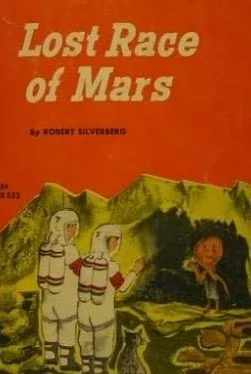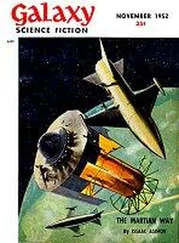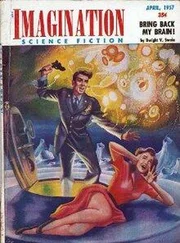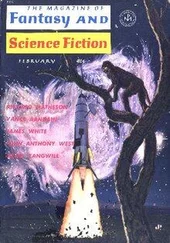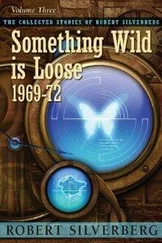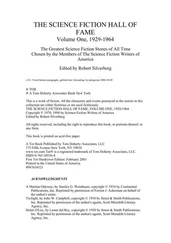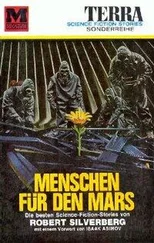Suddenly, Martin brought the sand-crawler to a halt. “We’re here,” he announced.
“Where?” Jim said. “I don’t see anything.”
“The entrance to the cave is hard to see. But I know where it is.”
Armed with camera and flashlights, they got out of the sand-crawler. Martin led them to a butte that jutted up some fifty yards away. As they drew closer, Sally asked, “Is that the entrance? That dark spot at the base of the cliff?”
“That’s right,” Martin answered. “The Old Martians all lived underground. Maybe they lived on the surface once, but that was so many millions of years ago that even the ruins are gone.
But we’ve found half a dozen of their underground caves. This one is nearest to the colony, and it’s also the most interesting.”
They reached the entrance. Jim peered into the darkness and could see nothing. Martin stepped around him and said, “There are steps cut into the rock, leading down. They’re very small, so walk carefully.”
They were very small steps, indeed, Jim thought. They were so tiny that the Old Martians must have been midgets two or three feet high to have used them. He picked his way down one step after the other, following Martin.
“We’re now about forty feet below the surface,” Martin announced when they had all reached the bottom. “This particular cave is about five hundred yards long. The ceiling of the passageway is only about six and a half feet high, and in some places it’ll be less, so you and I will have to watch our heads, Dr. Chambers.”
They began to walk. The flashlight beams cast ghostly flickers on the age-old walls of the cave.
“Look how smooth the walls are,” Sally said. “And everything is polished so neatly.”
“Yes, the Old Martians must have been great craftsmen,” Martin agreed. “Ah—now we come to the first dwelling place.” He pointed with his light. An archway about four feet high was cut in the wall of the cave. One by one, the Chamberses crept through the minute opening. They found themselves in a small chamber cut from the rock. It was not more than six feet from floor to ceiling, but it was broad and deep enough to make a good-sized bedroom.
There were faint marks on the wall. “What’s this?” Jim asked.
“It’s a Martian painting. Most of the paint had flaked off this one, but in some of the others they’re still in good shape. The dry climate preserves everything.”
They went on to the next chamber. It, too, was empty, but the wall painting was in better condition. It showed a lake surrounded by tall leafy trees. “That was a favorite theme of the Old Martian artists,” Martin commented. “All the other paintings we have also show Mars as it must have been millions of years ago—a young planet with water and fertile soil.”
Dr. Chambers took a snapshot of the painting, and they continued onward. Another chamber contained several actual mummified Old Martians, well preserved for at least ten thousand years.
There was not much to see—only three Old Martians lying at the rear of the cave. They were wrinkled, withered brown things no more than three feet in length, and it was very difficult to make out much detail. They had two arms and two little pipestem legs, and their heads seemed very large in proportion to their bodies. Their faces, after ten thousand years, were unrecognizable, and if they had ever had hair, they had none now.
For a long moment no one spoke. The sight of the Old Martians made everyone solemn. These people had been civilized when the ancestors of Earth men were still apes swinging through the trees. And now, barring the unexpected, it was safe to say that the last of them had died thousands of years ago. There was nothing left of the once-mighty inhabitants of Mars except a few withered mummies lying in dark caves below the desert.
Once again Dr. Chambers took photographs. Then they all moved on. Some of the other rooms contained pottery and small statues and pieces of abstract sculpture. There were attractive paintings on many walls. But the mustiness of the tomb hung over the entire cave. It had the stillness and the dryness of death.
Finally they reached the end of the tunnel, turned, and retraced their steps. Jim and Sally felt tired, though not so tired as they would have felt on Earth, thanks to the light gravity.
“I’m hungry,” Sally announced as they emerged into the sunlight.
“I am, too,” Jim chimed in. “What time is it, Dad?”
Dr. Chambers had the only wrist watch in the family that told Mars time. He wore it around the arm of his breathing suit. Their old wrist watches were of no use here, but he had borrowed this one from the colony authorities when they had arrived. The Martian day was about thirty-seven minutes longer than a day on Earth, and so each hour ticked off by a Martian wrist watch was a little more than a minute and a half longer than an Earth hour.
“It’s almost two o’clock,” Dr. Chambers said. “Time for lunch, sure enough.”
They entered the sand-crawler. Then, after making sure it was sealed tight, Martin permitted the emergency supply of air to enter it from the tanks below the seats. Now they could remove the helmets of their breathing suits and eat in the crawler.
After lunch, they headed back to the colony. There was little conversation. All of them felt awed by this glimpse of an age-old race.
Back in their own house, Jim said, “Do you still think there’s a chance the Old Martians are alive, Dad?”
Dr. Chambers shrugged. “There’s no reason why not. This planet maybe honeycombed with their caves. If they have some way of manufacturing air below the ground, they might very well have survived.
“How will you be able to find them, Dad?”
“The colony has a radar-equipped helicopter that’s used for detecting underground metal deposits. I’ve asked for the use of it. If we flew over the desert, using the radar eye to help us spot underground caves whose entrances aren’t visible to the naked eye, we might find something. Trouble is, they don’t want to let me have the helicopter.”
“Why not, Dad?” Sally asked. “If it’s what you need—”
“It’s being used for an exploration program right now. I have to wait my turn until they think they can spare it. That might be months.”
Jim shook his head bitterly. “You’d think they didn’t want you to get anywhere in your research, Dad!”
“Remember, son, they have a different idea about what’s important. And as long as we’re their guests, we have to stay in line and not argue too hard.”
Jim said nothing. But privately he found himself almost wishing the year would hurry up and end so he could get back to Earth and his friends and his cat. Poor Chipper! He had hardly thought about the tomcat since coming to Mars. Chipped was probably terribly lonely down there on Earth.
Two days later, Jim was reminded of Chipper again. It was late in the afternoon, and he and Sally were watching their father testing the metabolism of the desert rats when someone rang the bell below.
“I’ll get it,” Jim said, and hurried downstairs. He opened the door and looked up at a very tall, muscular colonist who was holding a box under each arm. The boxes had air hold punched in them.
“Your father home?” the man asked. “I have some animals here for him.”
“Sure. He’s upstairs in the laboratory. Follow me.”
The man’s name was John Webster. He was a mining engineer and had been searching the area south of the dome, hoping to find a deposit of radioactive metals. “I didn’t find any uranium,” he said, “but I did find there. They were wandering around in the desert, and they looked pretty lost. I’ve never seen animals like these before, and I’ve been here sixteen years last month.”
Читать дальше
